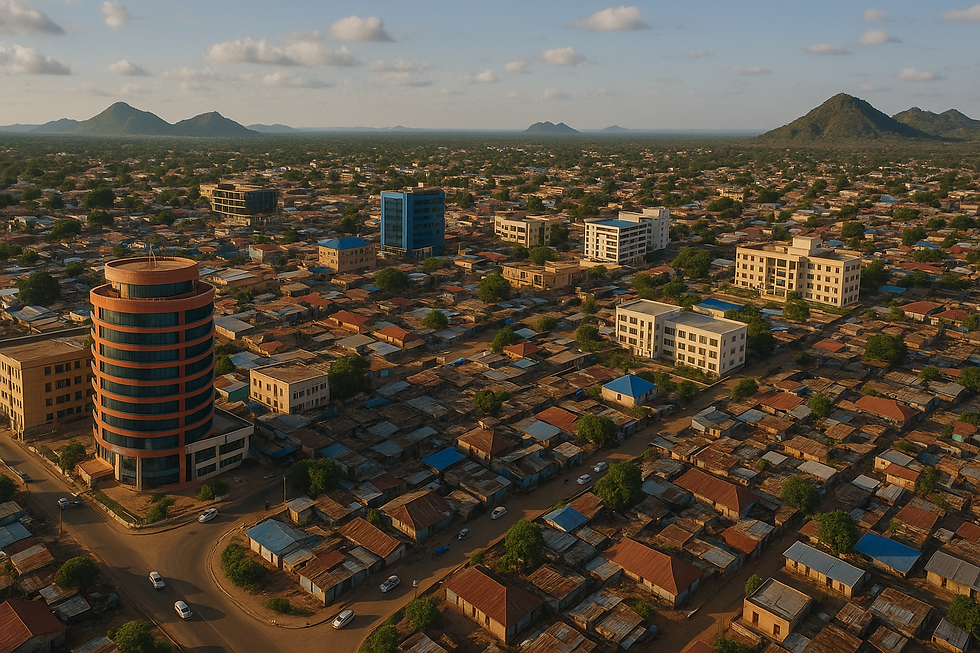Namibia’s ESG Horizon: Harnessing the Desert Wind for a Green Future
- tinchichan

- Aug 1
- 5 min read
In the vast desert landscapes of Southern Africa, Namibia is quietly scripting one of the continent’s most promising ESG stories. With a small population and expansive solar and wind resources, Namibia is emerging as a global testbed for green hydrogen, biodiversity protection, and governance-led sustainability.
Long overshadowed by its larger neighbors, Namibia is now being recognized as a model of climate-smart leadership, investor-friendly policy, and social inclusion amid ecological fragility. From the Kalahari to the Skeleton Coast, Namibia is turning its natural capital into a strategic asset for decarbonization, job creation, and international ESG alignment.

“We are not just adapting to climate change—we are building a green economy from the ground up,” says Tom Alweendo, Minister of Mines and Energy. “Namibia is open for sustainable business, and ESG is our investment language.”
1. ESG in Context: A Desert Nation with Deep Potential
Namibia is one of Africa’s most politically stable and economically open democracies, with a resource-rich economy and high climate vulnerability.
GDP (2024 est.): $14.8 billion
Population: ~2.7 million
GDP per capita: ~$5,500
Youth under 25: ~60%
Public debt: ~67% of GDP
Unemployment: 32% (youth: ~45%)
Inflation (2024): 5.9%
Key ESG drivers:
Climate exposure (drought, desertification, water stress)
High inequality (Gini coefficient: ~0.59)
Green hydrogen and rare earths as future growth engines
Commitment to rule of law, transparency, and environmental protection
Namibia is a member of the African Union, SADC, and UNECA, and is increasingly partnering with the EU and Germany on climate and ESG finance.
2. Environmental Sustainability: Resilience in a Changing Climate
2.1 Climate Risk and National Commitments
Namibia is one of the driest countries in sub-Saharan Africa, with:
<250 mm of annual rainfall in most regions
Increasing frequency of droughts, desertification, and water stress
Heavily reliant on transboundary water basins and boreholes
Despite this, Namibia is a low emitter:
GHG per capita: ~1.7 tCO₂e
Total GHG emissions: <0.03% of global total
Updated NDC (2021):
Unconditional reduction of ~15% by 2030
Conditional target: ~90% reduction with international support
Climate adaptation priorities:
Drought-resilient agriculture
Integrated water resource management
Ecosystem-based adaptation and early warning systems
2.2 Biodiversity and Ecosystem Leadership
Namibia is a global conservation success story:
43% of land under conservation (community, private, and national)
Rich biodiversity in Etosha, Namib-Naukluft, Skeleton Coast
World’s first country to enshrine environmental protection in its Constitution (Art. 95)
Key initiatives:
Community-Based Natural Resource Management (CBNRM):
86 communal conservancies
200,000+ rural people directly benefit from eco-tourism and wildlife
Namibia Nature-based Solutions (NbS) program launched in 2023
Climate-smart protected area network under GEF and UNEP support
3. Social Sustainability: Equity, Inclusion, and Human Development
3.1 Poverty, Inequality, and Social Protection
Despite macroeconomic stability, Namibia faces deep social disparities:
National poverty rate: 17.4%
Gini coefficient: ~0.59 (among the highest globally)
High informal employment and rural-urban gaps
Social ESG initiatives:
Social Protection Policy Framework (2022):
Consolidates pensions, child grants, and basic income pilots
National Youth Policy IV prioritizes green jobs and digital skills
Universal access to primary education and free healthcare
3.2 Gender and Indigenous Inclusion
Namibia scores high on gender equality in governance:
Women in Parliament: 44.2%
Gender parity in Cabinet and judiciary
Active civil society and women’s cooperatives in eco-tourism and agriculture
Efforts to include indigenous groups:
San, Ovahimba, and other minorities integrated into conservation and land reform
Cultural heritage preservation linked to sustainable tourism
Access to land, water, and education for marginalized communities
4. Governance: Stability, Transparency, and ESG Regulation
4.1 Political Integrity and Rule of Law
Namibia is consistently ranked among Africa’s best-governed countries:
Democracy Index (EIU): “Flawed Democracy” but improving
TI Corruption Rank (2023): 59/180
Independent judiciary and strong Auditor-General office
Key reforms:
Anti-Corruption Commission with prosecutorial powers
E-governance and procurement transparency platforms
Whistleblower Protection Act and access-to-information laws under review
4.2 ESG Regulation and Disclosure
Namibia is building a modern ESG framework:
Namibia Financial Institutions Supervisory Authority (NAMFISA) developing ESG disclosure guidelines
Namibian Stock Exchange (NSX) to introduce ESG reporting for listed firms by 2025
Development of a national green taxonomy in line with SADC and EU standards
Private sector:
Banks and pension funds exploring TCFD, GRI, and SASB frameworks
ESG integration in mining, tourism, and energy sectors
Corporate sustainability reporting rising in large firms (e.g., NamPower, B2Gold)
5. ESG Finance: Green Hydrogen, Bonds, and Blended Capital
5.1 Green Hydrogen Megaprojects
Namibia is leading Africa’s green hydrogen revolution:
$10 billion Hyphen Hydrogen Project in Tsau //Khaeb National Park
3 GW electrolyzer capacity, 5 GW renewables
Exports to EU, Germany, and regional markets
2023: Signed MoUs with EU, Germany, and Dutch investors
National Green Hydrogen Strategy focuses on:
Skills development
Environmental safeguards
Local beneficiation and job creation
5.2 ESG Finance Ecosystem
Namibia is developing green and sustainable finance instruments:
Sovereign green bond under development (expected 2025)
Green infrastructure PPP framework launched in 2023
Bank of Namibia exploring climate stress testing for banks
Development partners:
KfW, EU, AfDB, and GCF supporting pipeline of:
Renewable energy mini-grids
Sustainable agriculture
Climate-resilient urban planning
6. Carbon Emission Control: Three Transformational Pathways
6.1 Renewable Energy Scale-Up
Namibia has one of the world’s highest solar irradiance levels:
Current installed capacity: ~700 MW (70% renewables)
Target: 80% renewables by 2030
IPPs and off-grid solar growing rapidly
Projects:
Omburu Solar Plant (20 MW)
Diaz Wind Project (120 MW under construction)
Battery storage and grid modernization underway
6.2 Nature-Based Solutions and Carbon Markets
Namibia’s dryland forests and rangelands offer carbon sink potential:
REDD+ strategy aligned with SADC protocols
Carbon credit pilot in Zambezi and Kavango regions
GCF-funded ecosystem restoration and sustainable grazing programs
Future vision:
Develop voluntary carbon market platform
Integrate carbon finance into CBNRM and wildlife corridors
6.3 Green Mining and Critical Minerals
Namibia is rich in uranium, lithium, and rare earths—key to the global green transition:
ESG-aligned mining code under consultation (2024)
Environmental and social impact assessments (ESIAs) mandatory
Green certification schemes and community benefit-sharing agreements
Key projects:
Lofdal Rare Earth Project (REEs for EVs and wind turbines)
Lithium exploration in Erongo and Kunene
ESG-linked FDI incentives for responsible extraction
7. ESG Case Studies: Namibia in Action
Case Study 1: Hyphen Hydrogen Energy
One of Africa’s largest green hydrogen projects
Environmental and social safeguards built into design
Skills academy for 5,000+ Namibians in green tech
Case Study 2: Naankuse Wildlife Sanctuary
Integrates conservation, ecotourism, and rural employment
Carbon offset program and wildlife corridor management
Partnered with UNDP and private donors
Case Study 3: NamPower – State Utility Goes Green
70% renewable electricity generation
Grid modernization and regional energy trade
ESG reporting aligned with national sustainability goals
8. Comparative ESG Snapshot: Southern Africa and Global Peers
Indicator (2023) | Namibia | Botswana | South Africa | Morocco | Vietnam |
GHG per capita (tCO₂e) | 1.7 | 2.8 | 7.6 | 1.8 | 2.8 |
Renewable electricity (%) | 70% | 30% | 11% | 38% | 35% |
Sovereign green bond issued | No (planned) | No | Yes | Yes | Yes |
ESG disclosure regulation | Partial | Weak | Mandatory (JSE) | Partial | Mandatory |
Female labor force (%) | 49% | 49% | 46.8% | 24% | 47.2% |
TI Corruption Rank (2023) | 59/180 | 35 | 83 | 94 | 77 |
*Namibia leads in renewables and hydrogen, with strong biodiversity governance and democratic stability—but needs to scale green finance, ESG enforcement, and youth employment programs.
9. Strategic ESG Risks and Opportunities
Risks
High youth unemployment and income inequality
Water scarcity and climate-induced shocks
ESG capacity gaps in SMEs and local governments
Global commodity price volatility (mining and hydrogen)
Opportunities
Launch first sovereign green bond and ESG-aligned PPPs
Scale carbon markets via nature-based and biodiversity credits
Expand green hydrogen infrastructure and skills
Strengthen ESG disclosure regulation and taxonomies
Position Namibia as Africa’s ESG hydrogen and conservation hub
Conclusion: Namibia’s ESG Future Is Desert-Born, Hydrogen-Fueled, and Globally Relevant
Namibia is proving that small, dry, and remote doesn’t mean low-impact. With visionary climate leadership, strong governance, and natural wealth, Namibia is not just adapting—it is architecting a green future with local ownership and global alignment.



Comments